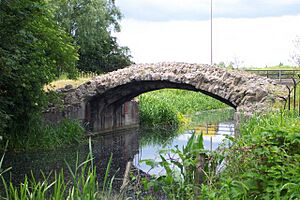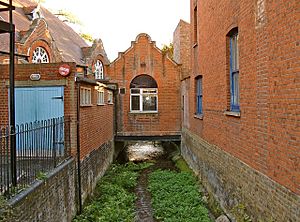Cornmill Stream facts for kids
The Cornmill Stream is a small river in Essex, England. It flows into the River Lea. A "tributary" is a smaller stream or river that flows into a larger one. This stream has an interesting history and flows through some important areas.
How the Stream Was Made
The Cornmill Stream is not a natural river. It is an artificial watercourse, which means people built it. It was likely created a very long time ago, possibly by the year 1086. Its main purpose was to power the mills in Waltham Abbey. These mills were important for grinding grain. They were even mentioned in the Domesday Book, a famous survey of England from 1086.
Where the Stream Flows
The Cornmill Stream starts near Fishers Green. Here, it leaves the River Lee Flood Relief Channel. This channel is sometimes called the Horsemill Stream.
From Fishers Green, the Cornmill Stream flows south. It creates the western border of the old Waltham Abbey Royal Gunpowder Mills. Then, it flows right through the Gunpowder Mills property. This area is a special place called the Waltham Abbey SSSI. An SSSI is a "Site of Special Scientific Interest," meaning it's important for its wildlife or geology.
Near Waltham Abbey town, the stream splits away from the Old River Lea. Both of these channels are part of another important natural area. This area is called the Cornmill Stream and Old River Lea, which is also an SSSI.
The stream then flows under a very old bridge called Harold's Bridge. This bridge was built in the 14th century, making it hundreds of years old! It also passes under the B194 road, known as Abbey View.
After that, the water goes through a special gate called a sluice. This sluice is located in the grounds of the abbey. The stream then flows underground for a bit. It comes out next to the Waltham Abbey town hall. Finally, after flowing through the town, it joins back up with the River Lee Flood Relief Channel.




